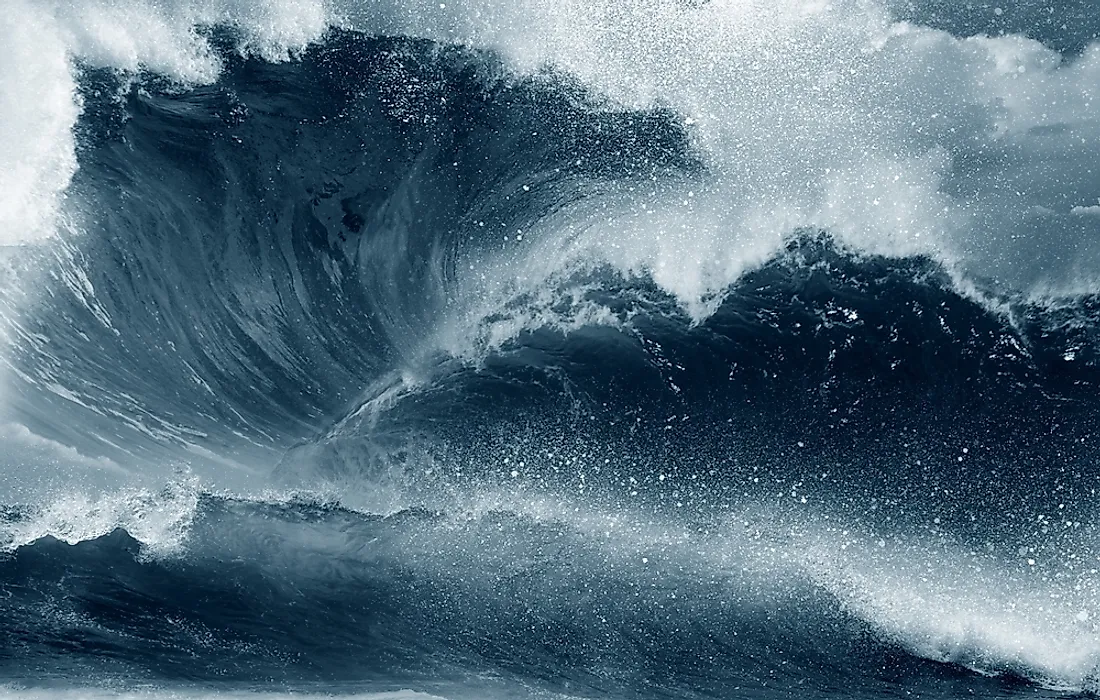What Was the Largest Wave Ever Recorded?

High waves are set off by many factors. High winds and storms create especially strong waves that gather force and height as it travels and as a result trigger high surf close to the beaches along coastal zones. This fact is especially dangerous since the timing of individual waves that come in sets of three to five waves between calm periods are unpredictable. Rogue waves are also the result of high winds and tidal conditions that may hit ships in mid-ocean. Low-pressure winds create ocean swells that develop into huge waves carrying high energy. Volcanic eruptions, landslides, and earthquakes also trigger fantastically huge waves called tsunamis that can reach two to three miles inland.
Seven Highest Waves
There are many types of waves and also different factors that create the right conditions for these types of waves to form. It is ironic that high powerful waves need land to reach their immense heights. True, the land is a crucial factor without which some types of waves could not achieve their towering mass. As it gets closer to the coastline, a wave must travel over shallow and shallower water, and its energy pushes the volume of that wave up to increase its height and release energy.
In 1958, a 100 feet high wave was generated in Alaska’s Lituya Bay during a landslide triggered earthquake event. Fortunately, the area was sparsely populated. On New Year’s Day in 1955, an 84 feet giant wave hit off the coast of Norway. This rogue wave was created by smaller waves that combined to form one huge wave. In 2011 off Nazare, Portugal, a surfer named Garrett McNamara, rode a confirmed 78-feet giant wave which is considered to be the biggest wave ever ridden by a surfer. In 2004, a 50 feet devastating earthquake-generated Tsunami wave hit off the coast of Sumatra, Indonesia. It killed about 200,000 people as it reached a mile inland. In Oahu, Hawaii, the Banzai Pipeline creates 30 feet high surfer waves that have claimed about ten lives as a result of being tossed into shallow reefs. In Hangzhou, China, in the months of September, a tidal bore called the Silver Dragon reaches a height of 29 feet as it moves along the Qiantang River against the river’s water current. In Teahupo’o, Tahiti, 25 feet high semi-circle breaking arc waves are the norm but local surfers named them the world’s heaviest due to their thick lips of water that are heavy and glassy that could throw surfers onto the cliff faces.
Destructive Waves
Mid-ocean waves during storms normally generate 10-30 feet high waves. These waves unfortunately sometimes reach the coastline and bring sufficient force that devastates populated inland areas. Usually, tsunamis occur several times a week as a result of underwater seismic events but are so minor that effects are too subtle. But when strong tsunamis happen, the signs are rapidly decreasing shoreline waters and the sudden increase that comes as rapid flooding but sometimes as huge monstrous waves that reach far inland. Most tsunamis come low but with an enormous force that sweeps everything in its way. Human lives, animals, and properties are lost where there is no escape even as far as three miles inland. Transportation is disabled as roads and highways are damaged and unpassable. All human-built structures are destroyed by the rushing ocean water. Diseases, contamination of every kind, and damage to land biome are just some more disastrous effects.
The Highest Waves Ever Recorded
| Rank | Wave Size (Feet) | Location |
|---|---|---|
| 1 | 100 | 1958, earthquake triggered tsunami in Alaska’s Lituya Bay |
| 2 | 84 | 1995, New Year’s Day, off the coast of Norway |
| 3 | 78 | 2011, off the coast of Nazare, Portugal |
| 4 | 50 | 2004, Indian Ocean Tsunami |
| 5 | 30 | Banzai Pipeline in Oahu, Hawaii |
| 6 | 29 | Off the coast of Hangzhou, China |
| 7 | 25 | Off the coast of Teahupo’o in Tahiti |











